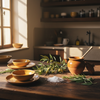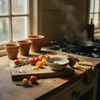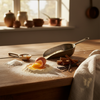Spatula vs Turner: Essential Guide for Home Chefs
Spatula vs Turner: Essential Kitchen Tools Demystified
Ah, the humble spatula and turner—those unsung heroes of our kitchen drawers. They're the tools we reach for without thinking, yet they're responsible for rescuing our pancake flips, scraping every last bit of brownie batter, and ensuring our fish fillets make it from pan to plate intact. But here's the culinary plot twist: these two kitchen MVPs are often confused for one another, and using the wrong one can be the difference between culinary triumph and kitchen tragedy.
At DI ORO, we've seen it all—the melted plastic disasters, the scratched non-stick pans, and the pancake flips that went terribly wrong. That's precisely why we're diving deep into the spatula vs turner debate. Because when you're armed with the right tool (and the right knowledge), your cooking confidence soars and your dishes follow suit.
The Essential Difference: Spatula vs Turner Defined
Let's clear up the confusion that's been simmering in kitchens across America. While many of us use "spatula" as a catch-all term (especially here in North America), these tools actually serve distinct purposes in the culinary world.
What Exactly Is a Spatula?
A true spatula is typically a flexible, flat tool designed for scraping, folding, and mixing. Think of it as your bowl's best friend—the tool that ensures not a drop of your grandmother's secret cake batter goes to waste. The classic spatula features a broad, flexible blade made from silicone, rubber, or plastic, attached to a handle that allows you to reach into the deepest corners of your mixing bowls.
The beauty of a high-quality silicone spatula, like DI ORO's award-winning Seamless Series (recognized by America's Test Kitchen as the Best All-Purpose Spatula), lies in its versatility. It moves effortlessly from mixing bowl to hot pan without melting—because nothing ruins a perfect sauce faster than melted plastic. Our pro-grade silicone withstands temperatures up to 600°F, meaning your spatula stays intact even when the cooking gets hot.
And What About a Turner?
A turner (sometimes called a "flipper" or incorrectly labeled a "spatula") is the flat, usually more rigid tool you use to—you guessed it—turn foods while cooking. With its angled head and sturdy construction, a turner is designed specifically for sliding under and flipping foods like pancakes, burgers, or delicate fish fillets.
The best turners, like our DI ORO Slotted Turner, feature a thin, beveled edge that slides smoothly under food without tearing it. Many turners also feature slots or perforations that allow excess oil or liquid to drain away—a small design detail that makes a massive difference in your final dish.
Material Matters: What Your Kitchen Tools Are Made Of
When it comes to spatulas and turners, material isn't just about aesthetics—it's about performance, safety, and the longevity of both your tools and cookware.
Spatula Materials: Flexibility with Purpose
Traditional spatulas come in various materials, each with distinct advantages:
- Silicone: The gold standard for modern spatulas. Heat-resistant (ours withstand up to 600°F), non-reactive with foods, and gentle on cookware. At DI ORO, we use only pro-grade silicone that's BPA-free, LFGB certified, and contains zero forever chemicals—because what touches your food matters.
- Rubber: The old-school option. Generally less heat-resistant and more prone to staining and odor absorption.
- Plastic: Often less expensive but can melt at lower temperatures and may contain concerning chemicals.
- Metal: Used primarily for spreading (think frosting spatulas) rather than mixing or scraping.
Turner Materials: Strength and Compatibility
Turners need to balance strength with surface compatibility:
- Stainless Steel: Exceptionally durable and perfect for high-heat cooking on stainless or cast iron surfaces. The downside? They can scratch non-stick coatings faster than you can say "warranty voided."
- Silicone: The non-stick pan's best friend. Our silicone turners combine flexibility with enough rigidity to flip even substantial foods without scratching your precious cookware.
- Nylon: Heat-resistant to varying degrees, but typically not as durable as high-quality silicone or metal options.
- Wood: The traditional choice. Gentle on pans but can absorb odors and stains over time, and may not stand up to dishwasher cleaning.
When to Reach for a Spatula
Your spatula is the versatile workhorse that excels at these essential kitchen tasks:
Scraping and Mixing Magic
There's something deeply satisfying about scraping every last bit of batter from a mixing bowl. A good spatula conforms to the bowl's curves, ensuring nothing goes to waste. This is where the flexibility of a silicone spatula truly shines—it bends without breaking, reaching places rigid tools simply can't.
For mixing tasks, especially when incorporating delicate ingredients like whipped egg whites or folding chocolate chips into cookie dough, a spatula's gentle touch preserves the texture you've worked so hard to achieve. The broad surface area distributes pressure evenly, preventing overmixing that can deflate your soufflé or toughen your muffins.
Hot Pan Heroes
Modern heat-resistant spatulas have revolutionized cooking by eliminating the need to switch tools when moving from mixing to cooking. With DI ORO's heat-proof spatulas, you can stir that risotto directly in the hot pan or scrape down the sides of your saucepan while making caramel without fear of melting disasters.
This heat resistance is particularly valuable when making scrambled eggs or delicate sauces, where the flexible edge can continually scrape the pan's surface, preventing sticking and ensuring even cooking. The result? Creamy scrambled eggs without the crusty pan residue—a win-win in any kitchen.
Spreading with Precision
Whether you're frosting a cake, spreading mayo on sandwiches, or applying a thin layer of butter to your bread dough, a spatula's flat, flexible surface distributes ingredients evenly. The control you get with a quality spatula means no more torn bread or patchy frosting—just smooth, professional-looking results every time.
And let's not forget the satisfaction of using a spatula to create those perfect swoops and swirls in your frosting. Even if you're not competing on a baking show, there's something undeniably delightful about those finishing touches that transform a simple cake into something special.
When to Reach for a Turner
While spatulas excel at mixing and scraping, turners are the unsung heroes of the hot cooking surface. Let's explore when this sturdy kitchen companion becomes indispensable.
The Art of the Perfect Flip
There's a certain culinary confidence that comes from executing the perfect flip. Whether you're sending a pancake airborne with a flick of the wrist or gently turning a delicate fish fillet, the right turner makes all the difference. The angled edge of a quality turner, like our DI ORO Slotted Turner, slides smoothly under food without tearing or breaking it—preserving both the integrity of your dish and your kitchen pride.
The best turner spatula designs feature a thin, beveled edge that slips effortlessly between food and cooking surface. This seemingly small design detail is actually the difference between picture-perfect pancakes and a pile of torn batter. Our customers often tell us that upgrading to a quality turner was the unexpected kitchen game-changer they never knew they needed.
Remember that viral video of the chef flipping an entire pan of fried rice? While we can't promise those acrobatics, we can confirm that the right turner gives you the control and confidence to attempt more ambitious flips—without the anxiety.
Heavy Lifting in the Kitchen
Turners are built for strength. When you need to transfer that perfectly seared steak from grill to plate, or lift an entire lasagna portion without it collapsing, a sturdy turner provides the support needed. The rigid construction distributes weight evenly, preventing those heartbreaking moments when food falls apart mid-transfer.
This strength becomes particularly important when handling foods with crispy exteriors. A quality turner maintains the structural integrity of your crispy-skinned fish or perfectly crusted hash browns, preserving the textural contrast that makes these dishes so satisfying.
For larger items like burgers or portobello mushrooms, a wider turner provides the surface area needed for complete support. No more chasing food around the pan with a tool that's too small for the job—just confident, controlled movement from cooking surface to serving plate.
The Drainage Advantage of Slotted Designs
Many turners feature slots or perforations—a design element that's far more functional than decorative. These openings allow excess oil, fat, or moisture to drain away as you lift food, resulting in crispier textures and less greasy results.
A slotted turner spatula is particularly valuable when working with fried foods, where that extra drainage can be the difference between gloriously crisp and disappointingly soggy. It's also ideal for removing blanched vegetables from boiling water or lifting roasted items that have released juices during cooking.
At DI ORO, our slotted turner designs balance drainage capability with structural integrity—ensuring that even delicate foods remain supported while excess liquid drains away. It's these thoughtful design elements that transform ordinary cooking into exceptional results.
Matching Tools to Cookware: Protection and Performance
 slotted turner spatula">
slotted turner spatula">
Using the right tool isn't just about cooking technique—it's about protecting your investment in quality cookware. The wrong material can scratch, damage, or even ruin expensive pans.
Protecting Your Non-Stick Surfaces
Non-stick cookware requires special consideration. Metal tools—even those marketed as "gentle"—can eventually scratch these delicate surfaces, compromising both performance and potentially releasing unwanted chemicals into your food.
For non-stick pans, silicone or nylon tools are the safest choice. DI ORO's silicone spatulas and turners are specifically designed to be non-stick safe while still providing the performance you need. The flexible edge conforms to the pan's surface without scratching, preserving your cookware's integrity meal after meal.
This compatibility is why so many high-end cookware manufacturers actually recommend silicone tools like ours—they understand that the right accessories extend the life of their products. Consider it relationship counseling for your pans and tools: when they work harmoniously, everyone's happier.
Cast Iron and Stainless Steel Partners
For hardier cooking surfaces like cast iron or stainless steel, you have more flexibility in your tool choice. Metal turners can be excellent options here, as their rigid edges can help release food that might be sticking to the surface.
However, even with these more durable surfaces, there are advantages to using silicone tools. They won't react with acidic foods, they're gentler on your cookware's seasoning, and they eliminate the metallic scraping sound that makes everyone in the kitchen cringe. Plus, our pro-grade silicone tools are heat-resistant enough to handle even the highest cooking temperatures these surfaces can reach.
The best approach? Build a collection that includes both metal and silicone options, allowing you to match the right tool to each specific cooking scenario. Your cookware will thank you with years of faithful service.
Beyond Basics: Specialized Turners and Spatulas
While we've covered the fundamental differences between spatulas and turners, the culinary world offers specialized variations that excel at specific tasks.
The Fish Spatula: A Turner's Specialized Cousin
The fish spatula (which is actually a type of turner) features an extra-thin, flexible edge and widely-spaced slots. This design allows it to slide under delicate fish fillets without tearing the skin, while the slots drain away excess moisture for perfectly crispy results.
But don't let the name limit you—this versatile tool excels at handling all sorts of delicate foods, from thin pancakes to freshly-baked cookies. Many professional chefs consider it the most versatile turner in their arsenal, proving that sometimes specialized tools have surprisingly broad applications.
The Offset Spatula: Precision in Pastry
In the baking world, the offset spatula (with its angled blade that creates clearance between your hand and the work surface) is the secret weapon for perfectly smooth frosting. The narrow, flexible metal blade provides unparalleled control for detailed work.
While not designed for mixing or high-heat cooking, this specialized tool transforms ordinary cakes into professional-looking masterpieces. It's the perfect example of how the right tool can elevate your results from "homemade" to "could have been purchased at a bakery."
At DI ORO, we believe in tools that solve specific problems exceptionally well—which is why our product development always starts with understanding the unique challenges home chefs face in their everyday cooking adventures.
The Spoonula: When Worlds Collide
Sometimes the best innovation comes from combining existing concepts. Enter the spoonula—a hybrid tool that merges the scraping power of a spatula with the scooping capability of a spoon. This versatile tool excels at tasks that require both functions, like transferring semi-liquid batters or serving saucy dishes.
Our DI ORO Spoonula, recognized by Food Network as the Best Spoonula, features the same pro-grade, forever-chemical-free silicone as our award-winning spatulas. It's the perfect example of thoughtful design that anticipates the real needs of home chefs who want to do more with fewer tools.
Creating Your Essential Tool Collection

When building your kitchen arsenal, understanding the spatula vs turner distinction helps you make informed choices. Let's explore how to curate the perfect collection that meets all your culinary needs without cluttering your drawers.
The Must-Have Spatula and Turner Duo
For the minimalist chef, a high-quality silicone spatula and a versatile turner form the foundation of an efficient kitchen. The spatula handles your mixing, scraping, and folding needs, while the turner manages all your flipping and serving tasks. This dynamic duo can tackle approximately 90% of your everyday cooking challenges.
At DI ORO, we've seen countless customers transform their cooking experience with just these two tools. Our award-winning Seamless Silicone Spatula (the one America's Test Kitchen couldn't stop raving about) paired with our Slotted Turner creates the perfect partnership for everything from weeknight dinners to ambitious weekend projects.
Think of them as the culinary equivalent of a great pair of jeans and a white t-shirt—versatile classics that never let you down. When you invest in quality versions of these essentials, you'll find yourself reaching for them again and again.
Expanding Your Collection Strategically
As your cooking adventures grow more ambitious, you might consider adding specialized tools. Rather than accumulating random gadgets, think strategically about the cooking techniques you use most frequently.
Love baking? Add an offset spatula for frosting and a smaller silicone spatula for getting into jar corners. Grill enthusiast? A long-handled turner keeps your hands safely away from the flames. Preparing delicate fish regularly? A dedicated fish turner with its ultra-thin edge makes a world of difference.
The best turner spatula collections grow organically alongside your culinary skills. Each addition should solve a specific problem or significantly improve a frequent cooking task. This approach keeps your drawer organized and ensures every tool earns its keep.
Material Matters: Choosing Quality That Lasts
The spatula vs turner decision isn't just about shape and function—material quality dramatically impacts performance, durability, and even food safety.
The Silicone Revolution
Pro-grade silicone has revolutionized kitchen tools, offering heat resistance, flexibility, and non-stick properties without the health concerns associated with some plastics. Not all silicone is created equal, however. At DI ORO, we use only LFGB-certified, forever-chemical-free silicone that withstands temperatures up to 600°F without melting, warping, or releasing harmful compounds.
This material superiority is why our spatulas and turners maintain their performance year after year, while lesser tools quickly degrade. The slight premium for quality silicone pays dividends in longevity and peace of mind—particularly important for tools that directly contact your food.
When selecting silicone tools, look for that crucial heat-resistance rating and food-grade certification. The spatula that melts against your hot pan isn't just an inconvenience—it's potentially introducing unwanted chemicals into your carefully prepared meal.
The Case for Stainless Steel
For certain turner applications, particularly with cast iron cookware, stainless steel offers unmatched durability and precision. The thin, beveled edge of a quality stainless turner slides under food with surgical precision, while the rigid structure supports even heavy items without bending.
The key quality indicator for metal turners is one-piece construction, where the metal extends fully through the handle. This eliminates the weak point where head and handle meet—often the first failure point in lesser tools. When you hold a well-made stainless turner, you'll immediately notice the balanced weight and solid feel that signals lasting quality.
Whether you choose silicone, stainless steel, or both, investing in tools made from superior materials transforms your cooking experience from frustration to flow. As the saying goes: "Buy once, cry once."
Caring for Your Kitchen Tools
Quality spatulas and turners can last for years—even decades—with proper care. These simple maintenance practices protect your investment and ensure your tools remain safe and effective.
Cleaning Best Practices
While most DI ORO tools are dishwasher-safe, hand washing extends their life and preserves their finish. For silicone spatulas and turners, warm soapy water and a soft cloth remove most residue without harsh scrubbing. For stubborn stains on silicone, a paste of baking soda and water works wonders without damaging the material.
For stainless steel turners, avoid abrasive cleaners that can scratch the surface. Instead, soak briefly to loosen stuck-on food, then wash normally. Dry immediately to prevent water spots, particularly if you store your tools displayed in the open.
Remember that proper cleaning isn't just about aesthetics—it's about food safety. The seamless design of quality tools like our DI ORO spatulas eliminates the crevices where bacteria can hide, making thorough cleaning both easier and more effective.
Storage Solutions
How you store your spatulas and turners affects both their longevity and your cooking efficiency. Cramming them into overcrowded drawers can damage edges and handles, while making it frustrating to find the right tool when needed.
Consider a countertop crock for frequently used items, a drawer organizer with designated slots, or even a simple hanging system. Whatever method you choose, the goal is to protect each tool while keeping it easily accessible. After all, even the best turner spatula can't help you if it's buried under a jumble of gadgets when you need it.
Conclusion: The Right Tool for Every Task
Understanding the fundamental spatula vs turner distinction elevates your cooking from functional to exceptional. While they may look similar at a glance, these tools serve distinctly different purposes in the kitchen—and choosing the right one for each task makes all the difference in your results.
At DI ORO, we believe cooking should be joyful, not frustrating. Our award-winning, pro-grade, chemical-free kitchen tools perform beautifully and keep your food safe. From scraping batter with our Seamless Spatula to flipping pancakes with our Slotted Turner, our tools are made by people who know what matters—so you can focus on creating delicious memories.
For a full overview of spatulas and tongs, see The Ultimate Guide to Spatulas and Tongs. To learn about spatula types and their uses, check out this helpful guide.
Frequently Asked Questions
Why is a spatula now called a turner?
The term 'turner' became popular to describe a specific type of spatula designed primarily for flipping or turning food items like pancakes or burgers. Over time, as kitchen tools evolved, the word 'turner' helped differentiate this flat, wide implement from other spatulas used for mixing or scraping. Essentially, 'turner' highlights the tool's function rather than just its shape.
Is a pancake turner a spatula?
Yes, a pancake turner is a type of spatula specifically designed for flipping pancakes. It typically has a broad, flat surface that slides easily under delicate foods, making it perfect for turning pancakes without breaking them. While all pancake turners are spatulas, not all spatulas are suitable for flipping pancakes due to differences in shape and flexibility.
What is the correct term for a spatula?
The correct term for a spatula depends on its specific use and design. Generally, a spatula refers to a broad, flat kitchen tool used for mixing, spreading, or lifting food. However, tools like 'turners' or 'scrapers' fall under the broader category of spatulas but have more specialized names based on their function.
What's the difference between spatula and flipper?
A spatula is a versatile kitchen tool used for mixing, spreading, or scraping, whereas a flipper is a type of spatula specifically designed for lifting and turning foods during cooking. Flippers usually have a wide, flat surface with slots to help release food easily, making them ideal for flipping items like burgers or pancakes. So, all flippers are spatulas, but not all spatulas are flippers.
What do chefs call spatulas?
Chefs often use more precise terms based on the spatula’s function, such as 'turner' for flipping tools, 'scraper' for flexible rubber spatulas, or 'palette knife' in baking. While 'spatula' is a common general term, professional kitchens prefer specific names to avoid confusion and ensure the right tool is used for each task.
What is a spider skimmer used for?
A spider skimmer is a wire-mesh tool used primarily for lifting food out of hot oil or boiling water while allowing liquids to drain quickly. Its wide, shallow basket shape makes it perfect for frying or blanching, helping chefs remove items like fried foods or boiled vegetables without excess oil or water. It’s a staple in many kitchens for safely handling hot, delicate foods.
As we dive into the joys of summer, don't miss out on our Summer Sale! It's the perfect time to upgrade your kitchen tools and grab your favorite DI ORO products at great prices. From versatile spatulas to premium turners, everything you need for the perfect summer meals is now on sale.
-
Posted in
best turner spatula





